For those who want the ultimate traveling experience and full access to their coach while they’re on the road, Class A motorhomes are the RV of choice. Sitting behind that panoramic windshield in a recliner-like chair as you cruise down the highway is a feeling like no other.
We’ll show you everything there is to know about these rolling homes. As a potential buyer, you’ll gain perspective on what to expect to find and the many manufacturers that build them. If you’re still deciding, we’re going to show you the pros and cons of this category to help you make an informed decision.
Key Points
- Class A motorhomes are the most expensive RV category
- Class A RVs began before most other categories
- RV manufacturers design many of the diesel pusher versions for full-time living
- The Government Accountability Office (GAO) Act is making National Park campsites Class A-friendly
- You don’t need a special driver’s license to drive a Class A motorhome
What Is a Class A RV?
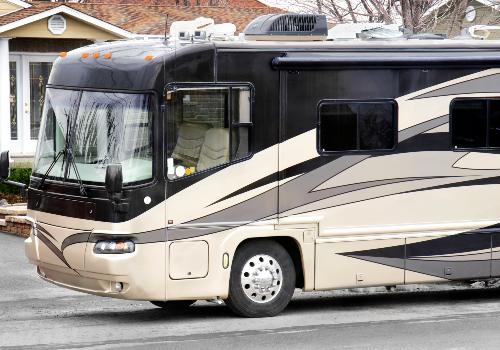
Class A motorhomes, which are RVs you can drive, are constructed on medium to heavy-duty truck chassis. They have a generally rectangular form and are frequently likened to buses. The interiors of Class A RVs boast amenities similar to those found in homes and incorporate advanced technology, prioritizing comfort over concerns about weight.
Class A motorhomes have a lot of advantages. You’ll find they’re the most spacious, have the largest holding tanks, and will last longer than most towable travel trailers. Glampers and those looking for longer RV adventures gravitate towards this category since their price points are in the six-figures.
History of Class A Motorhomes
The “A” in Class A has a purpose. The category was the first to develop in the drivable RV realm. The most famous from the Antique Era (Pre-World War II) was the Conklin Family “Gypsy Van.”
On August 21, 1915, the 8-ton, 25-foot custom-built “house car” (the defining term for motorhomes during that period) started its journey from Huntington, New York, to San Francisco, California. For the next two months, every newspaper, from the New York Times to the local town Gazette, published their journey as they passed by.
For the 1940 World’s Fair, GM built 12 V6 custom motorcoaches for their “Parade of Progress.” The GM Futurliners stretch 33-feet and have a future art-deco design (futuristic for 1940). As of 2007, nine are known to exist. Current owners will sometimes feature them at RV shows across the country.
As the years rolled by, other custom-built wonders would appear using a bus chassis. It took 50 years from Roland Conklin’s ride before the first mass-produced Class A RV would hit President Eisenhower’s Interstate Highway System.
In 1961, Ray Frank designed and built his first drivable RV using a Dodge Chassis and had a Chrysler 318 CID V8 as a powerplant. From 1965 until the late 1980s, the Dodge Travco was as iconic as Airstream is for towables. As time progressed, the newer models would shave the boxy edges off for more aerodynamic curves.
Shortly after Ray Frank started producing his Travco, another fledgling company made its first Class A motorhome. In 1961, a California company moved to Iowa at the request of newfound investors. In 1966, Winnebago launched their first motorhome: The Brave.
You can find other fascinating Class A motorhomes from the Vintage and Classic eras at the RV Hall of Fame in Elkhart, Indiana. You’ll recognize some names like the Fleetwood Pace Arrow or the GMC Motorhome (a.k.a. The “Submarine”).
Class A Gassers

Class A motorhomes get their nicknames from their engine types. In this case, Class A gas RVs have the moniker of “gassers.” Short Class A RVs and mid-size versions are designed for part-time use of these chassis. Price points are more affordable, and amenities are mid-grade. RVers will choose a gasser over a diesel because the upkeep is more affordable.
Top-end gassers will have the look and features of their diesel counterparts. A great example is the Forest River Georgetown GT7. Its full body paint, Thomas Payne Brand furniture, and other high-class features are indistinguishable from Berkshire diesel.
Class A Front-End Diesels (FRED)
Recently, Freightliner reintroduced a front-end diesel (FRED) chassis. A few decades ago, the RV industry perfected an affordable way to place the diesel engine in the coach’s rear. Once that happened, the industry focused all of its diesels on the diesel pusher chassis.
Consumers who like Gasser Class A RV floor plans but want diesel performance are choosing FRED chassis. Newmar’s Canyon Star is a perfect example of this. Newmar has kept this gasser one of the premier motorhomes in this sub-class. Once Freightliner launched the FRED chassis, Newmar customers have enjoyed having the choice between fuel types.
Class A Diesel Pushers (DP)
The nickname “diesel pusher” refers to the rear engine sending all the power to the back wheels. There are two advantages to this configuration. The first has to do with the engine size. The biggest diesel Class A RVs can have engines that crank out over 600 horsepower.
The second advantage is the placement of the diesel generator. In diesel pushers, the generator is placed upfront under the driver’s section. In dry camping situations, if you need to keep the generator going overnight, you can sleep comfortably without the noise.
Class A Motorhome Specification Ranges
| Lengths | 25-45 feet |
| Sleep | 2-10 people |
| Fuel type | Gas or diesel |
| Price | $75,000-$3,000,000 |
Gas Mileage of a Class A RV
The average gas mileage for a Class A motorhome ranges between 6-14 miles per gallon (MPG). From a fuel standpoint, you could be asking which is better, a diesel or gas motorhome. Diesel has better fuel efficiency than unleaded gas. That’s why commercial vehicles use diesel.
Expect a gasser to perform between 6-10 MPG on an 80-gallon tank. Diesels will average 7-14 MPG on an 80-200 gallon fuel tank. On paper, the choice is clear. Yet, with so many factors to consider when choosing the perfect Class A RV for you, it gets complicated.
The best way to stretch out your fuel economy is to make sure your tires are at their optimum pressure, keep your oil maintained, and your overall gross vehicle weight at a reasonable level. You can learn more about RV weight factors and more in our feature article that discusses this essential topic.
Popular Chassis
Generally speaking, RV manufacturers use the Ford chassis for gassers. Diesels mostly use one of the Freightliner chassis, but the Spartan chassis has a substantial presence. No matter the diesel chassis, Cummins is the engine of choice. Manufacturers will pair up diesel chassis and engines differently than shown below based on individual RV models’ requirements.
- Ford F-53 chassis, 7.3L V8 Triton Gas- 430 hp @ 475 lb./ft. (New for 2021)
- Ford F-53 chassis, 6.8L V10 Triton Gas- 310/362 hp @ 425/457 lb./ft. (1999-2020)
- Freightliner MC chassis, 6.7L V6 Cummins B- 340 hp @ 700 lb./ft.
- Freightliner XCR chassis, 8.9L V6, Cummins ISL9- 450 hp @ 1,250 lb./ft.
- Freightliner XCM chassis, 8.9L V6 Cummins X12- 500 hp @ 1,695 lb./ft.
- Freightliner SLM chassis, 15L V6 Cummins X15- 605 hp @ 1,950 lb./ft.
- Spartan K2 chassis or Spartan K3 Chassis
Popular RV Manufacturers of Class A RV
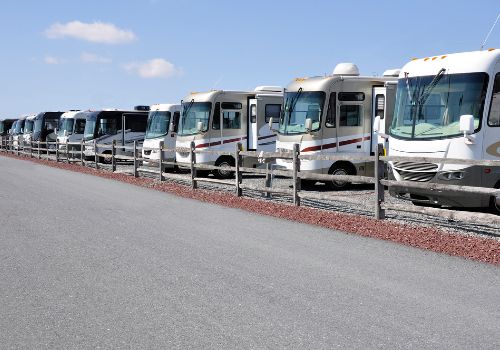
Entry into the Class A RV market is a daunting venture. The Big Four (Forest River Inc, REV Group, Thor Ind., and Winnebago Ind.) have the resources to stay on the cutting edge of innovation and the financial stability to produce these complex vehicles.
Independents like Tiffin Motorhomes began back in the 1970s and became a leader early on. Other independents like Prevost and Embassy exist in the multi-million dollar market, which sets them apart from competing on the main stage.
An exception to the rule is Nexus RV. This small independent manufacturer was a success story that came out of the 2008 financial crisis. While other RV manufacturers were going out of business or getting absorbed, they set up shop and have continued to build quality motorhomes despite being the underdog.
| BRAND | MANUFACTURER |
| American Coach | REV Group |
| Coachmen | Forest River Inc. |
| Embassy RV | Independent |
| Entegra Coach | Thor Ind. |
| Fleetwood | Group |
| Forest River | Forest River Inc. |
| Foretravel | Independent |
| Holiday Rambler | REV Group |
| Jayco | Thor Ind. |
| Monaco | REV Group |
| Newmar | Winnebago Ind. |
| Nexus | Independent |
| Prevost | Independent |
| Terra Wind | Independent |
| Thor Motorcoach | Thor Ind. |
| Tiffin | Independent |
| Winnebago | Winnebago Ind. |
Great Examples of Class A Motorhomes
| The smallest class A RV | Thor Axis 24.1 |
| The best class A RV with 2 full bathrooms | Winnebago Forza 38D |
| Best Class A RV with bunks | Newmar Canyon Star 3929 |
| The best luxury class A RV | Foretravel Realm FS6 |
| Best class A wheelchair accessible RV | Newmar Dutch Star 4311 |
| The class A motorhome brand for full-time living | Tiffin Motorhomes |
| The best amphibious class A motorhome | CAMI Terra Wind |
Features You Can Expect In a Class A Motorhome
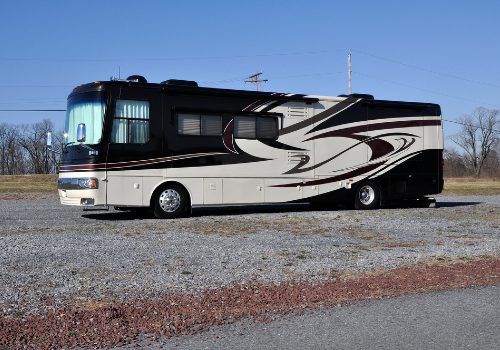
The features will differ between a Class A RV under 30 feet and a luxury model with a price tag of over $1 million. No matter which version you choose, when you walk into any Class A RV, you can expect to find a certain level of features that are category standards. Overall, you will see a clear separation between sections.
Kitchen
The kitchen will have either residential or near-residential-level appliances. Some small gassers even come with outdoor kitchens. Main kitchens will have everything you need to prepare large family meals. Stoves may be propane gas or induction
Living Room
Sofas will fold out for guest-sleeping. You may find a loveseat sofa or two-seater theater seat. LED TVs may come premounted, have reinforced spaces to mount your own, or have cabinets with televators. Some models have two recliners that are perfect for enjoying your morning coffee or a good book.
Bedroom
RV manufacturers are opting for king-size beds over queens. Memory foam and innerspring are the standard choices. Manufacturers spend some money on quality mattresses, but they assume most of their customers will replace them with their own. Adjustable frames where the head lifts to a sitting position are popular features.
Wardrobe systems take up bedroom walls for the most space for all of your clothing and personal items. Class A RVs with washers and dryers aren’t common, but closet spaces prepped for the machines are. The prepped closet is in the bathroom or hallway between the master bedroom and living room.
Bathroom
Class A RVs have dry bathrooms. You’ll either see the shower separate from the water closet or an all-in-one bathroom with everything contained. Mid-sized Class A RVs with 2 bathrooms are more common than ever.
The rear master bathroom could feature a two-sink vanity, a spacious shower including a bench, and ornamental tiling. The bathroom located in the middle of the coach might be a half bath or a full one equipped with a shower. This arrangement provides guests access to restroom facilities while allowing owners to maintain the privacy of their master suite.
Storage Tanks
The biggest diesel Class A RVs have the largest water-holding tanks in the industry. Today’s dual bathrooms plumb both into a single grey and black tank. Some RV makers still use separate waste tanks for the secondary bathroom. No matter the case, they’re all routed to one sewer connection port.
Since 2018, RV manufacturers have been sealing the underbelly of the coach. They also plumb heating ducts around the holding tanks to prevent freezing. This can create extra costs if you ever have to service your motorhome. The repair technicians may have to remove the seal panels to get to the problem. If so, make sure they replace it properly.
Power and Propane
With a long and sturdy roof, Class A RVs are perfect for multi-panel solar systems. Many Class A motorhomes have so many electronics; inverters are becoming standard features. House batteries have been standard for decades. Before you install your solar system, seek professional advice and research for the best methods.
Built-in generators on Class A motorhomes are a decades-old technology. Through the years, they’ve become quieter and more fuel-efficient. You can use them to power the RV while you’re driving or dry camping. If your fuel tank reaches a quarter tank, it will shut off as a safety feature, so you have enough gas to reach the closest service station.
With so many components becoming electronic, you may find that your new Class A RV doesn’t have a propane tank. That’s due to your kitchen devices, refrigerator, and coach furnace being electronic. If your coach does use LP, your tank is built-in and is accessible in one of your exterior bays.
Coach Technology
As you look around your new Class A motorhome, you’ll wonder if you’re driving a mechanical machine or a rolling computer. You’ll find multiple LED TVs, a state-of-the-art sound system, the latest in kitchen technology, and many other features new to the RV world.
Driver Area
If you’re a child of the 1980s, you’ll remember David Hasselhoff driving that black Trans Am every week on TV. K.I.T.T. would be jealous of the features today’s Class A motorhomes have.
Want to Connect With a Community of Over 1,078 RV Enthusiasts?
Many have two different screens in the driver’s area. The first connects to the rear and side cameras. The second is your sound system, GPS, and internet-ready screen for other resources. Top-end models even use an LED display for your gauges. Of course, you can’t forget the one-touch auto-leveling jacks. (sorry, no rocket booster)
Towing Capacity
Class A RV towing capacities range from 5,000- 10,000 pounds. Gassers will stay at the 5,000-pound range. You won’t have a problem flat-towing your vehicle; bring your boat or other motorized adventure toys with you.
You can attach a hitch-mounted cargo carrier for an ATV on 40-foot diesel Class A RVs that fold up against the coach. The carrier allows you to bring your ATV and still flat-tow your passenger vehicle legally.
Matching to Your Camping Style
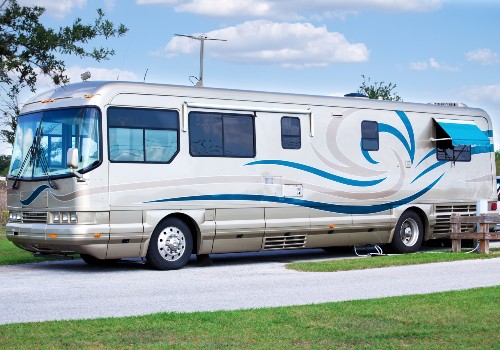
Positive Class A RV Reviews and Ratings
Some small Class A RVs with outdoor kitchens and incredible exterior entertainment features are perfect for tailgaters. Many weekenders and part-timers find that Class A RVs under 30 feet have all the benefits they want, making their price points justifiable.
Families find Class A motorhomes spacious and comfortable to travel in. Everyone can stretch out and have their own space. Class A RV manufacturers install seatbelts in sofas and dinettes so everyone can ride securely. You’ll find other safety measures throughout the motorcoach for everyone’s protection. A great example is the top bunk gates that prevent kids from rolling off.
Luxury Class A RVs appeal to empty nesters who want to enjoy their life on the road. Recently, couples who still have their careers have decided to work on the road in these rolling palaces. With the latest technology and the highest caliber furnishings, the distinction between a luxury motorhome and a high-end home has more similarities than differences.
Nothing compares to the traveling experience in a Class A motorhome. The pilot seats have the feel of your favorite recliner. Top-end chairs have heating, cooling, and massage technology built-in. Co-pilots can kick back and relax with the footrest up and the chair back fully reclined.
Many people wonder if you need a special license to drive a Class A RV. Generally, you don’t. As long as your motorcoach is under 26,000 pounds, 45 feet or less, and is not being used for commercial purposes, the driver’s license you have for your passenger vehicle works. A handful of states may require a specialized license for the longest versions, so check with your DMV.
You may not need a particular driver’s license, but we always recommend taking an online RV training course if this is your first Class A motorhome. Industry expert teaches these training programs. You’ll learn how to operate your new RV and pick up valuable tips on maneuvering your coach through traffic.
Is A Class A RV Worth It?
Since the average length limit of national parks is 30 feet, finding a suitable campsite can be difficult. Even if you can fit, smaller national park campgrounds have tight turns and rough roads too tricky for your rig. Until the Great American Outdoors Act modifications are complete, dropping your jacks at the nearby private parks is your best bet.
Boondocking in a Class A motorhome has its pros and cons. From a security standpoint, you never have to leave the confines of your RV. Once you find a place to park, you can drop your jacks, deploy your slideouts, and get some sleep.
The tricky part is finding a place to park. Staying overnight at Walmart parking lots isn’t as simple as it used to be. Using an RV mapping website or app to find dry camping locations ahead of time is a smart move. Some states have restrictions on how long you can stay at rest stops, and travel centers fill up pretty quickly with commercial trucks.
Finally, owning a Class A RV requires more upkeep than towable and other drivable RVs. The costs of care on the automotive and coach maintenance are higher. A complete oil change service for the diesel engine and generator can reach up to $600. Replacing a tire can cost $500 or more. Joining a discount RV club can help you lower these costs.
The Next Step
Are you ready to get started on your RV adventure in a Class A motorhome of your own? Before you head to the RV dealership, we recommend you rent a few of them first. Class A RVs are a significant investment. People often purchase an RV they think is right for them but later find out it doesn’t fit their lifestyle and end up with buyer’s remorse.
Using a peer-to-peer rental company like Outdoorsy or RVshare is the best way to try before you buy. Instead of a stripped-down fleet vehicle, you have the opportunity to experience a motorcoach owned by real owners. You can try different brands with different floor plans.
After you’ve decided which floor plan and brand fits you best, you can continue your search through the RV Troop website to get an unbiased virtual walkthrough of the latest models on the market. We’ll show you the best features, what industry experts have to say, and what consumers point out.
Once you have the facts and first-hand knowledge, you’ll be fully prepared to buy the best model for you and your family.
Welcome to the RV lifestyle!
Perfect Class A Motorhome for Full-Time Living (Video)
"Man cannot discover new oceans unless he has the courage to lose sight of the shore."
-- Andre Gide

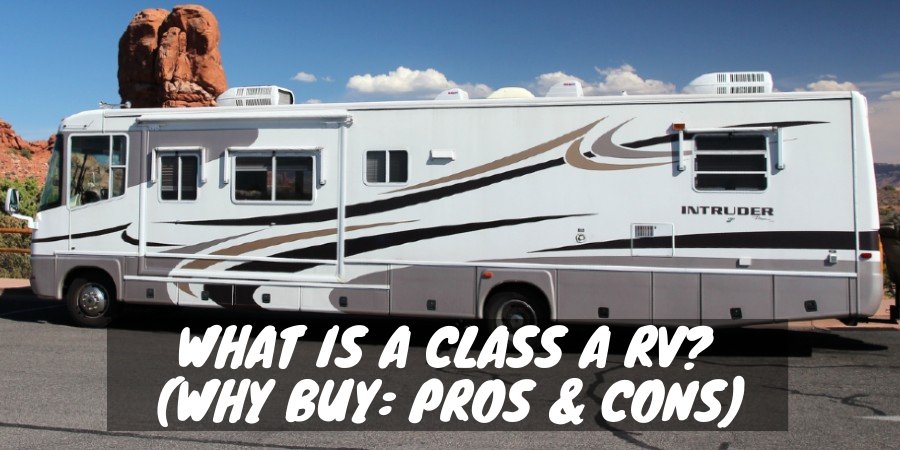

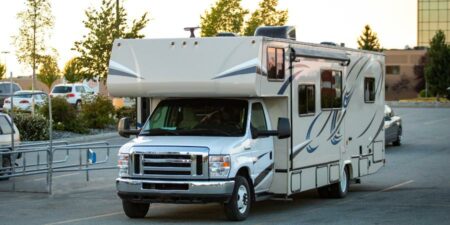








We were in the market for an under 35’ long Class A to replace our 2004 Class C. Unfortunately all Class As available in this length range, Gas and diesel, have such long rear overhangs they drive terribly for long trips. Can you imagine what a pickup truck would look like if the US RV companies made it? The rear axle would be right behind the seats. It is terrible engineering- cars haven’t been made like that since the boats of the 1950s and early 1960s. The Ford F53 chassis is a great design until they weld 8’ of frame extension to the back and unweight the front axle like a teeter-totter. We’re keeping our Class C and hope someday, someone will make a well designed, well built Class A.